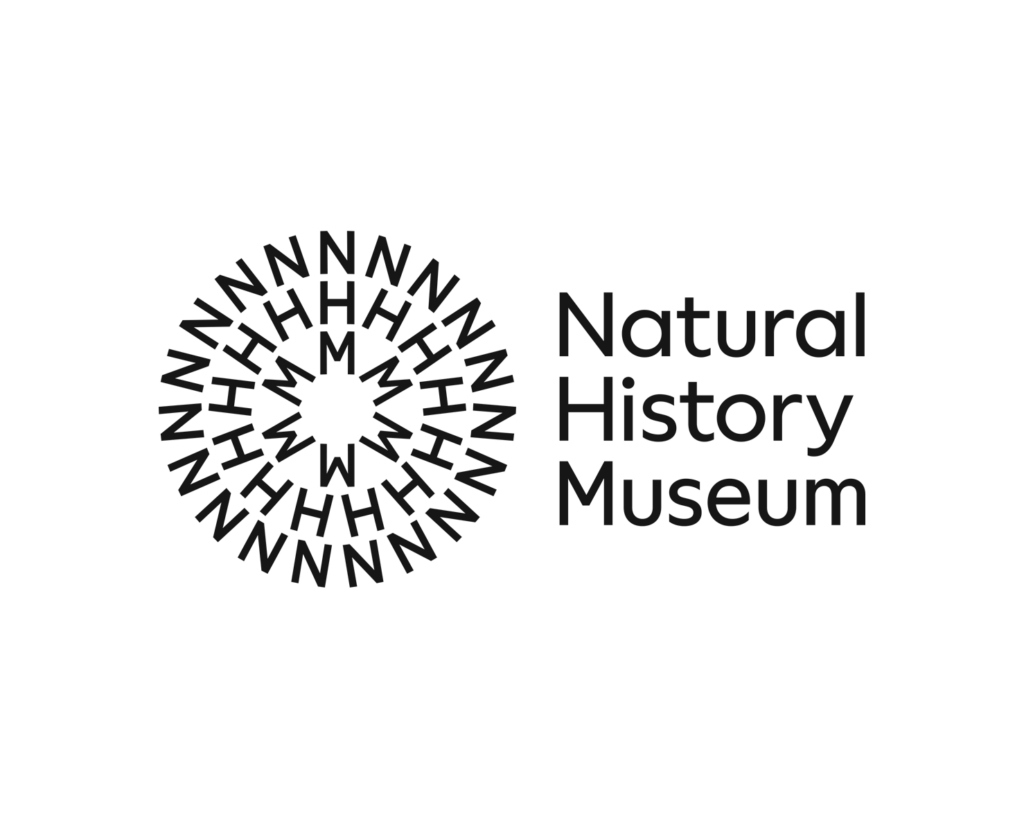The Sloane Lab awards Community Fellowships to contribute to “The Sloane Lab: Looking back to build future shared collections”, led by University College London (UCL) in partnership with the Technische Universität Darmstadt, British Museum (BM) and Natural History Museum (NHM). The fellows are undertaking creative, critical, practice and/or research-led projects with the Sloane Lab’s Knowledge Base and data, demonstrating the new forms of analysis and interpretation the project unlocks.
For the latest news from Sloane Lab Community Fellows and funding calls please check:
Sloane Lab Community Fellows
- Dr Gayle Chong Kwan – Travelling Taxonomies
- Dr Dorothy Kyagaba Sebbowa – Anti-Colonial Annotations of Sloane Jamaican references: Inquires into African Slavery
- Anna Sofia Lippolis – Exploring polyvocal knowledge in the Sloane collections
- Rosemary Grennan – Collections of Collections: Building Common Ownership and Shared Archival Practices
- Dr Rosalind White – In the Margins of Early Modern Science: Pioneering Women in Sloane’s ‘Paper Museum’
- Phillip Olney – The collection and accurate arrangement of these curiosities”: The Display Strategies of Hans Sloane’s Collection as ‘bifocal data’
- Hannah Cusworth – Bringing Sloane into Conversation with Blackness: Rest, Resistance and Refusal
- Charmaine Watkiss – Investigating ancestral cures: herbs and healing traditions of the transatlantic Caribbean
- Gethin Rees – A Generous Approach to Web Mapping Sloane’s Collections
- Joanna Byszuk – Exploring Sloane Lab collections with word vectors
Dr Gayle Chong Kwan
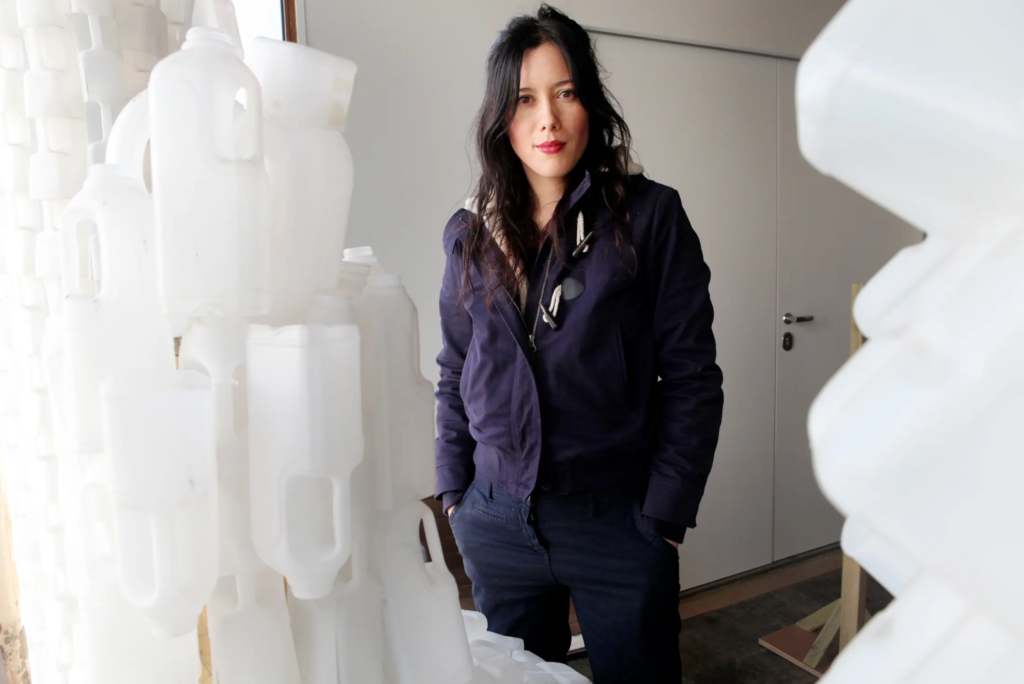
Project: Travelling Taxonomies
This research focuses on Sloane’s changing display of objects in his cabinets and the different configurations in which he presented and performed them to visitors. It seeks to complicate taxonomic boundaries and hierarchies that underpin objects’ organisation and display by ascribing cabinets and objects anthropomorphic tendencies, trickster and anarchic animal traits and the creation of object tales.
Travelling Taxonomies explores movement, flow, flux, and instability in Sloane’s ‘Miscellanies’, objects that by their very designation were considered to sit outside clear categorisation. This project conceives of the display cabinets as imperial devouring monsters and the objects within as resistors to their framing and confinement.
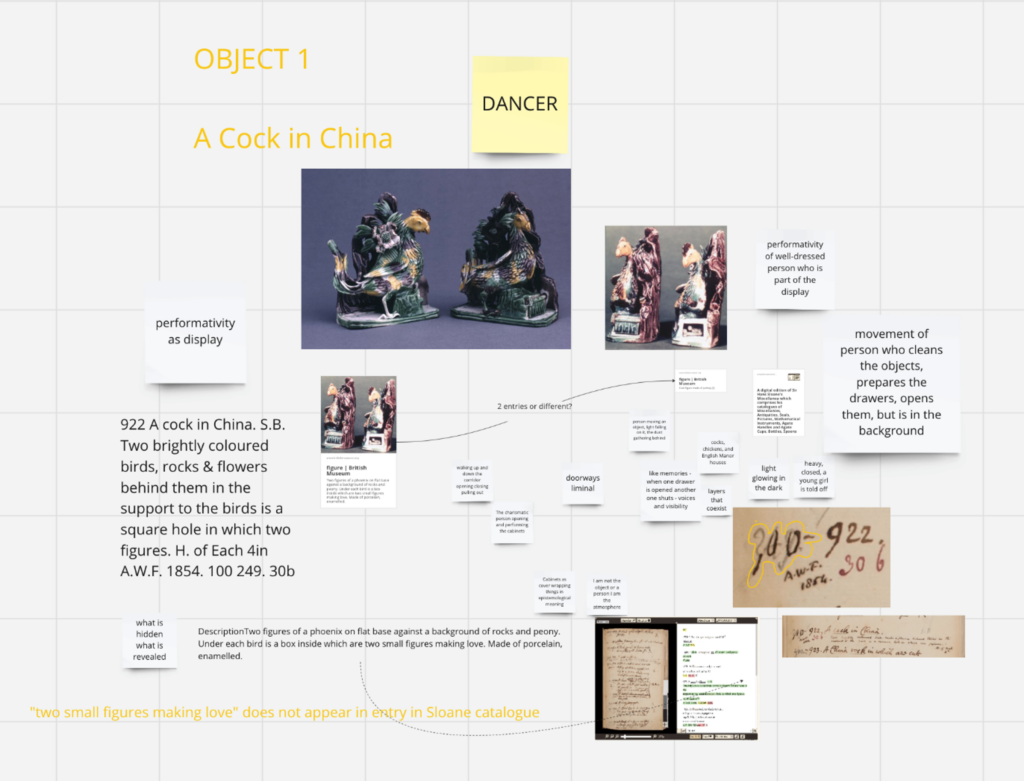
Miro Board mind map “A Cock in China”
Travelling Taxonomies drew upon existing research to create a dataset by ‘tabulating’ objects from Sloane’s ‘Miscellanies’ that moved between cabinets. A selection of these objects – located in his catalogues as title, textual description, and as additional pencil markings alongside the entries – were the starting point for engagement activities with movement practitioners, including a dancer, drummer, actor, dance journalist, gardener, and art therapist. Images and/or catalogue entries were the starting point for imaginative and physical sessions that considered movement inherent in the objects, how they moved between cabinets and why, and movement inspired by or that connected to the participants own practice. In resistance to the tendency to classify, categorise, and record, during these sessions nothing was noted or materially created.
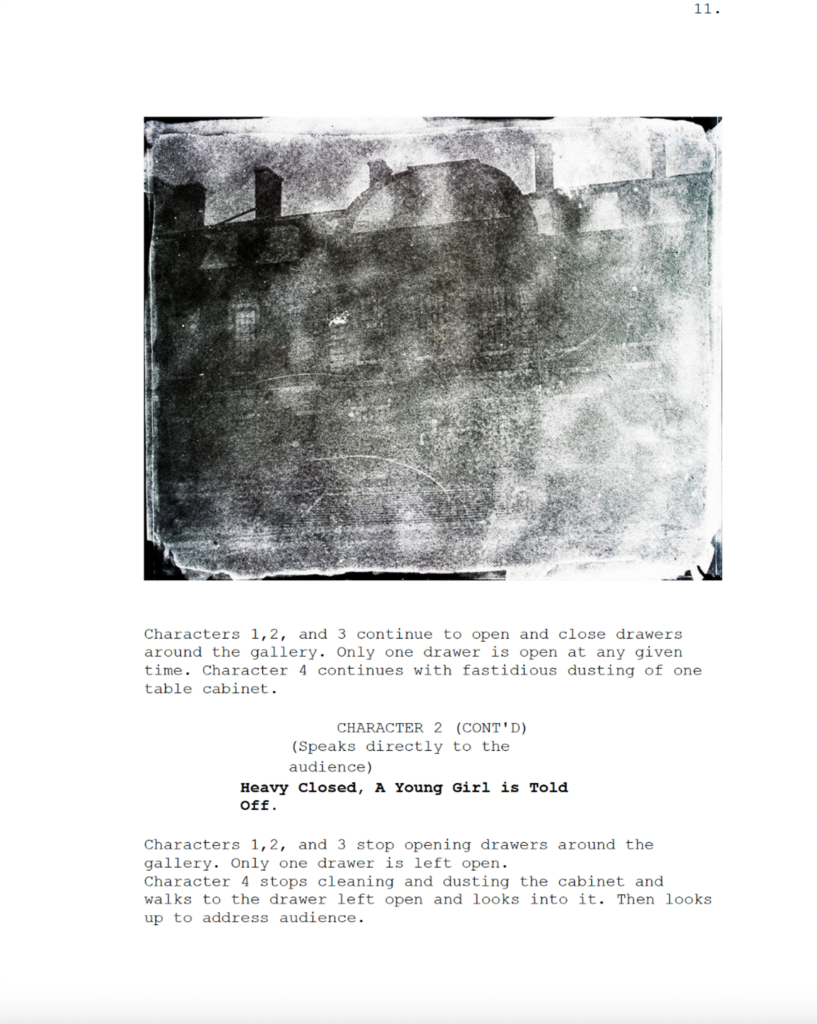
Extract from Travelling Taxonomies ballet proposal
This approach to data research led to the outputs of: a data set of objects that moved between cabinets; Miro Board mind maps; and a ‘Proposal for a Ballet’ that is set in the Enlightenment Gallery of the British Museum, in which objects from Sloane’s collection are currently shown. Part script, movement notation, images, and sound piece this work is a disruption or recomposing of the form as a recognition of the ways objects were brought into European/Western framing and reference. It is a choreography of movement in which taxonomies travel as creative resistance to hierarchies of confinement and control.
The project’s database is available on GitHub:
Dr Dorothy Kyagaba Sebbowa
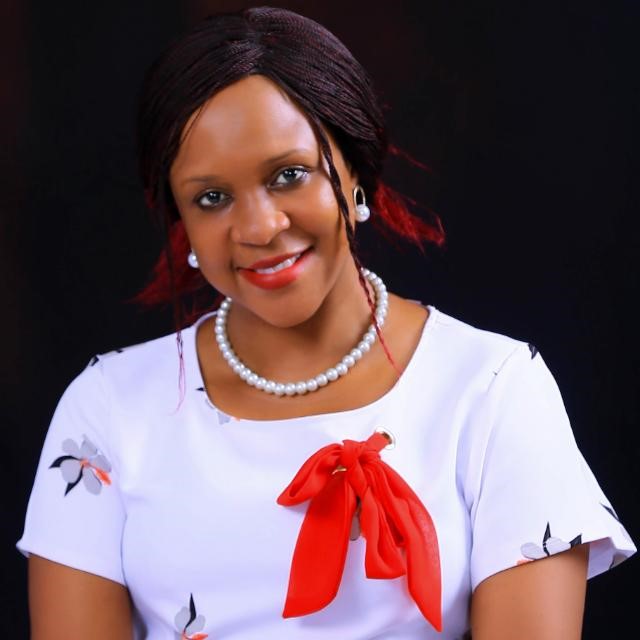
Project: Anti-Colonial Annotations of Sloane Jamaican references: Inquires into African Slavery
This project draws on the guide to the Sloane Database produced by the Natural History Museum before the Sloane Lab project as the key unit of analysis. It seeks to reinstate the experience of enslaved people and the history of slavery as the prism through which to explore and understand this data by examining the historicities, technologies and methodologies through the lens of Sloane’s involvement in the local of Jamaica and African enslavement. This project was prompted by the absence of this context in the publicly accessible data provided by the Natural History Museum about the Sloane Database prior to the Sloane Lab. .
The project inquiries into the ways that digitally mediated annotations can support the articulation and inscription of previously ignored or marginalized anti-colonial readings of the historical and curatorial-mediated archive. The historical hermeneutical methodological lens was employed to guide the critical perspectives and analysis.
The output of the research consists of an educational tutorial, online workshops and publication upon receiving funding. The educational tutorial hosted on the Wiki platform can be collaboratively edited and re-useable as an Open Educational Resource for academic researchers, archivists, museum curators. Additionally, it can be used as a platform for educational settings such as high school, teacher education, university courses on history, slavery, (anti) colonialism and decolonization.
The Educational tutorial is accessible on: http://sbb2023.pbworks.com/w/page/153540849/FrontPage
Anna Sofia Lippolis
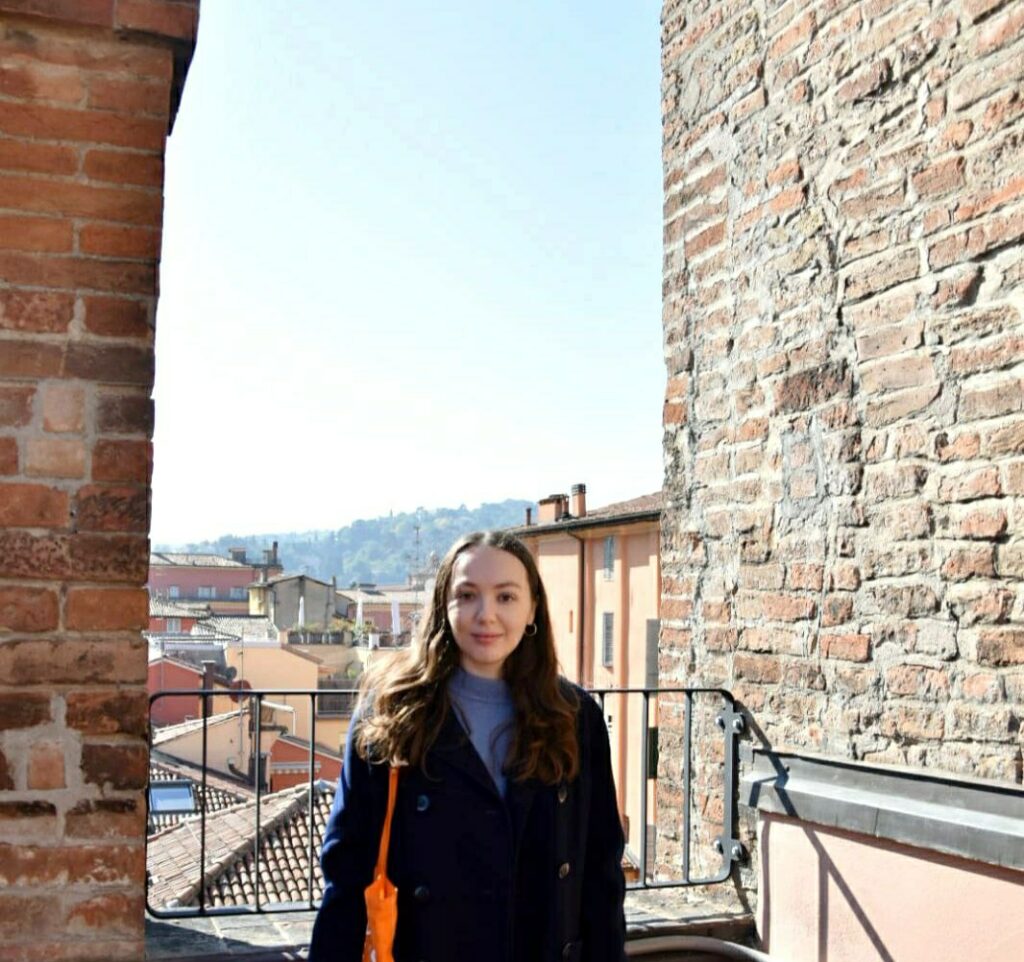
Project: Exploring polyvocal knowledge in the Sloane collections
This project is grounded in the concept of polyvocality, aiming to enable researchers to represent historical biases and diverse conceptualizations of objects in a machine-readable format. This approach sought to enhance the user experience of online collections by illuminating various perspectives and contexts. The primary goal was to develop design patterns within these collections to develop an ontological module for polyvocal sources. Such an ontology would empower users to query the collections, yielding results that highlight controversial items as well as provide explanations for the responses given.
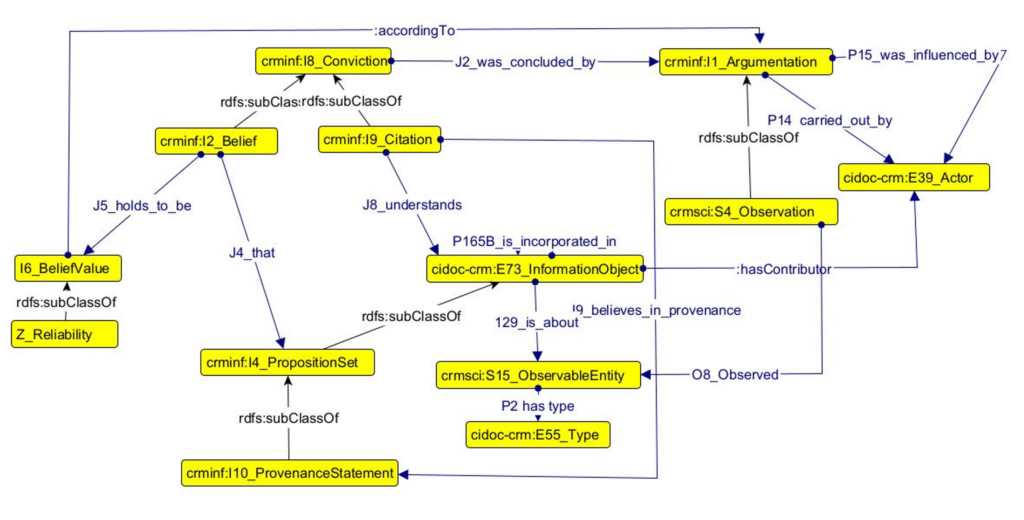
A diagram representing the ontological structure of multivocality for a cultural heritage information model, with various elements like Belief, Conviction, and Actor connected by properties within the CIDOC CRM framework
The main output of this research was the development and publication of the ontology, along with its integration with relevant items from the collections and comprehensive documentation of the tools used throughout the process. Additionally, the project explored the possibility to reuse this ontology in other contexts and assess its effectiveness in educational environments, such as high school and university courses focusing on history and colonialism.
Project outputs:
- The Multivocality Ontology model, in .ttl format
- The documentation of the ontology, along with competency questions, requirements, user stories and use cases
- A report of the Fellowship
The outputs are available on GitHub: https://github.com/dersuchendee/SLCommunityFellowship
Rosemary Grennan
Project: Collections of Collections: Building Common Ownership and Shared Archival Practices
The fellowship aims to redefine the concept of shared ownership ‘national collection(s)’ by integrating them with community collections to explore often contested histories. With a focus on community-led archiving, the project develops digital tools and workflows based on peer-to-peer protocols to democratise access and management of collections, encouraging a decentralised approach to cataloguing and record annotation. It will develop new Free/Libre and Open Source Software (FLOSS) workflows and tools that decentralise data storage, moving away from reliance on a single server to a network of user-maintained content. It will highlight the role of community libraries in the national data infrastructure, by distributing Hans Sloane’s collection datasets across various organisations, to emphasise distributed ownership and collective care. These tools and workshops will facilitate the annotation, sharing, and integration of the Sloane datasets and digitisations with different collections and contexts. This approach aims to transform static catalogues into dynamic, “writable” platforms, challenging conventional archival methods and fostering a more inclusive and participatory approach to documenting historical material.
Rosemary Grennan is the Co-Director of MayDay Rooms – an archive dedicated to the history of social struggles, resistance campaigns and experimental culture. She is also the co-founder of AGIT, a residency space in Berlin focusing on social movement history and culture. She is currently a Community Fellow at the Sloane Lab, at UCL.
Project outputs are available at: Collections of Collections
Dr Rosalind White
Project: In the Margins of Early Modern Science: Pioneering Women in Sloane’s ‘Paper Museum’
Tucked away in the margins of Sloane’s catalogues lies the untold stories of countless individuals whose contributions to science have largely remained in the shadows. In the Margins of Early Modern Science: Pioneering Women in Sloane’s ‘Paper Museum’ seeks to illuminate the intricate and vital roles that women played in the scientific networks of the early modern period.
The project leverages the rich repository of data provided by the Sloane Lab Knowledge Base to explore the contributions of women within Sloane’s “Paper Museum” — a vast compendium comprising over 1,000 illustrated books, 100 picture albums, an estimated 60,000 drawings, prints, and paintings, as well as manuscript catalogues spanning thousands of handwritten pages.
To document her research, Dr Rosalind White developed three new resources — an online exhibition, dataset, and research guide — that together showcase how the SLKB can serve as a dynamic resource for critical inquiry.
Project outputs:
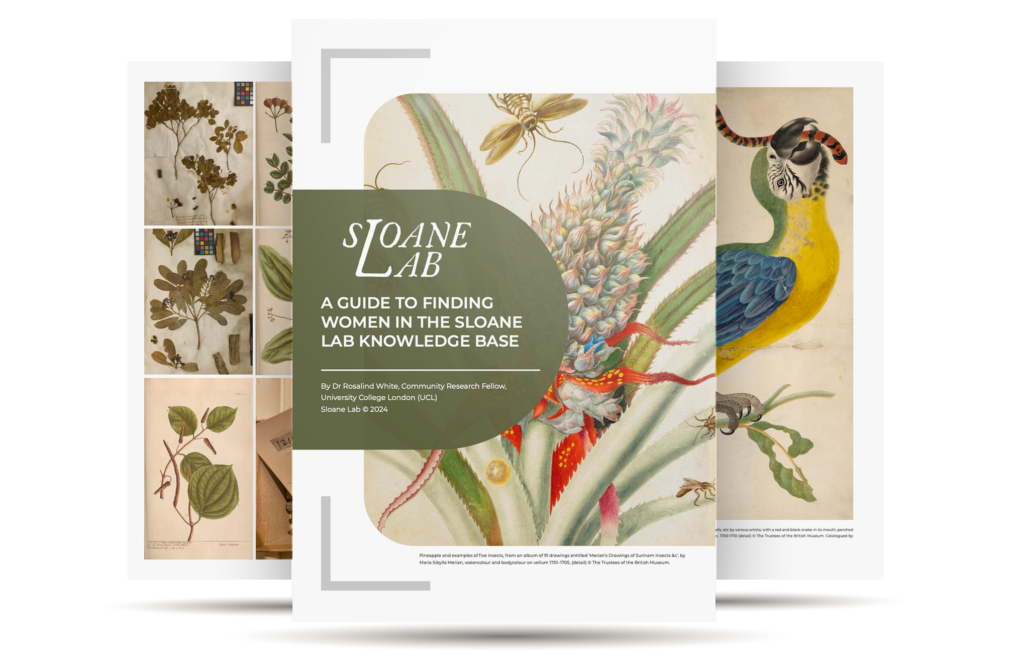
A Guide to Finding Women in the Sloane Lab Knowledge Base offers a practical starting point for researchers seeking to uncover the hidden narratives of women in Sloane’s collections. It outlines the methodological approach used to identify women’s contributions, highlighting how often these roles are obscured by gaps in the original cataloguing efforts, where names and direct references to women’s involvement are frequently absent. The guide is part of a broader effort to enhance how narratives of marginalised individuals are accessed, understood, and valued within the SLKB. The guide can be downloaded as a PDF file in both double-page and single-page view.
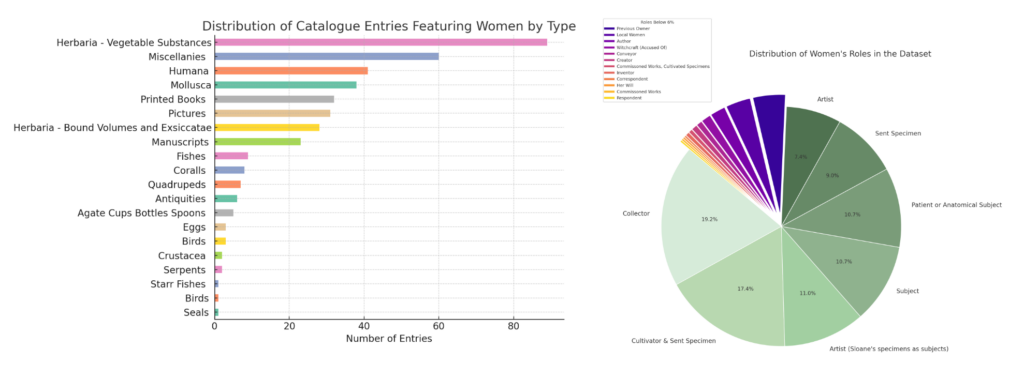
The dataset establishes a foundation for enhancing the representation of women within Hans Sloane’s collections through the Sloane Lab Knowledge Base. It offers a snapshot of the various ways women are documented and represented in the collections detailing their roles (e.g., artist, author), the type of entries associated with them (e.g., Pictures Catalogue Entry, Printed Books Catalogue Entry), as well as additional information about their work or the context of their contributions. Where possible, a link has been provided to each entry in the SLKB, allowing for deeper exploration. The dataset can be downloaded as Excel file (.xlsx) or in CSV format.
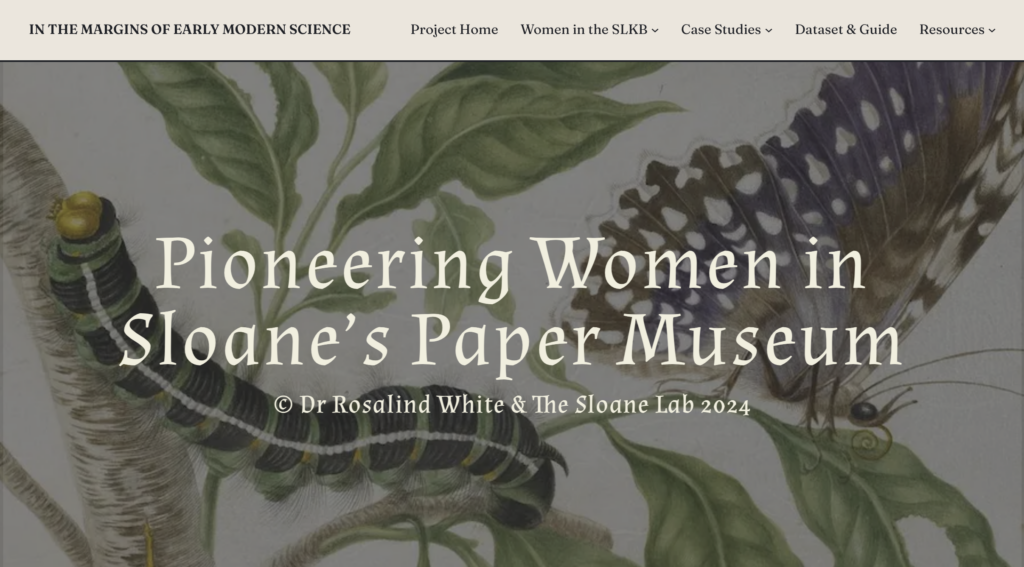
The online exhibition, In the Margins of Early Modern Science: Pioneering Women in Sloane’s ‘Paper Museum’, invites users to explore the untold stories of the women who shaped Sir Hans Sloane’s vast collections. Research cases studies are brought to life through a variety of interactive exhibits.
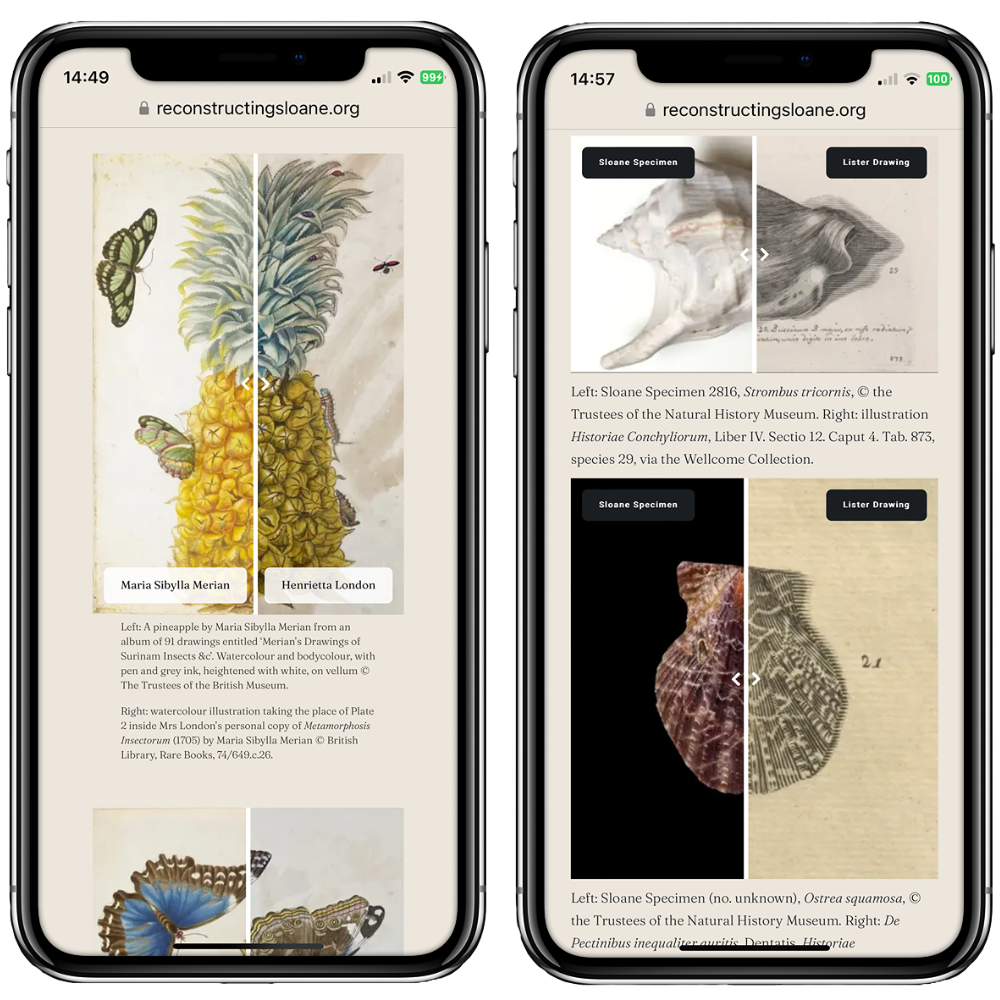
The exhibition spotlights the work of Elizabeth Blackwell, author and artist of A Curious Herbal; horticultural virtuoso Mary Somerset, the Duchess of Beaufort; and illustrators Anna and Susannah Lister, daughters of conchologist Martin Lister. It also highlights contributions from lesser-known women, such as botanical artists Ellen and Margery Power, and the mysterious ‘Mrs. London,’ whose watercolour illustrations appear in her personal copy of Maria Sibylla Merian’s Insects of Surinam.
Phillip Olney

Project: The collection and accurate arrangement of these curiosities”: The Display Strategies of Hans Sloane’s Collection as ‘bifocal data’
If Hans Sloane’s manuscript catalogues are ‘paper tools’ through which ‘Enlightenment knowledge was produced and circulated’ (Ortolja-Baird et al, 2019), then the cabinets within which this vast collection were first stored, and later displayed are similar ‘tools’ which assisted his efforts to classify, cross-reference and understand his collections.
This project seeks to gain an understanding of the way in which the objects of Sloane’s collection were stored in his residences in Bloomsbury and Chelsea. The project then asks to what degree the physicality of the collection in cabinets designed by William Hallett affected their curation, and organisation. By physically and digitally modelling these cabinets, the project hopes to understand to what extent these cabinets enabled processes of curation and proposes to track re-locations throughout the collection’s early history.
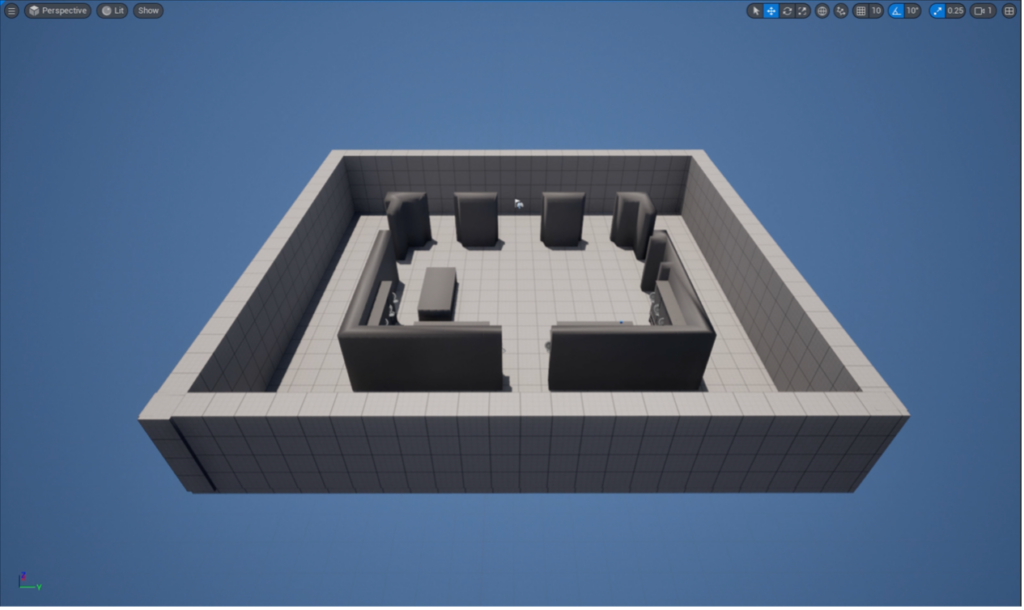
3D models of Hallet’s cabinets
The project understands Hallett’s cabinets to be ‘bifocal data’– a framing technique which requires the observer to look both ‘at’ and ‘through’ them (Sperberg-McQueen, 2018). The completed project will posit theories as to how storage of Sloane’s collection created organisational principles, and influenced the curation of the collection at the British Museum at Montagu House, in 1753, and later at the British Library and Natural History Museum.
Hannah Cusworth

Project: Bringing Sloane into Conversation with Blackness: Rest, Resistance and Refusal
What does it mean to view Hans Sloane through a Black Studies lens? During my community fellowship, I was guided by Black Studies thinkers at critical junctures. Their work transformed how I conceived of the project, the research I undertook and how I tried to live during those three months. Deciding not to travel to Jamaica or to do any ethnographic data collection, the project instead used the collections at the Natural History Museum and British Library in an attempt to find the Black everyday in the archive. What became apparent was the value of rest as a mode of resistance and refusal as a restorative practice.
Project outputs, currently in progress, include a presentation as part of the Sloane Lab seminar series and a journal article about my research journey.
Charmaine Watkiss

Project: Investigating ancestral cures: herbs and healing traditions of the transatlantic Caribbean
This project primarily draws on the information contained in Hans Sloane’s A voyage to the islands Madera, Barbados, Nieves, S. Christophers and Jamaica. Volume one of which focusses on Hans Sloane’s time spent in Jamaica from 1687 and his observations of the flora, fauna and people he encountered there. Volume 2, written almost 20 years after his initial visit to Jamaica, contains updated information along with engravings.
This research is particularly focused on the cultural and botanical practices and knowledge of Indigenous and enslaved African people in Jamaica; which is extensively documented in his two volumes. The information contained within these published works benefitted Sloane and his contemporaries, and demonstrates the cultural and botanical understanding of enslaved and indigenous people. The books demonstrate their advanced knowledge of the land and the medicinal qualities of the plants that were grown. Much of this information helped to advance western science but has still not been widely acknowledged. Therefore my purpose with this fellowship to find out as much as possible about what Hans Sloane observed during his time in Jamaica, and also what information was sent to him by his contemporaries. I am also interested in discovering what cultural traditions survived the transatlantic and fed in to the culture of the Caribbean that we know today. In order to do that I will be accessing data from the Vegetable substances that Hans Sloane collected, much of which was gathered by enslaved people and is housed in the Sloane Herbarium at the Natural History Museum. Looking at these specimens and reading the notes which Sloane wrote will give an invaluable window into the past.
I will then be creating data sets of the Sloane collection which focusses on Jamaican material, incorporating all of the plants that I have identified in my research. I will then create sub data sets which lists plants employed for sacred use. I will also construct a plant Thesaurus which has common colloquial names for plants so that it is easy for the lay person to search the database without having to know scientific names of plants. Within this thesaurus will be the healing properties of the plants. I will finally create a plant family tree which highlights stories connected to a select number of plants.
I am hoping to build a rich cultural context of this period in history, and provide another layer of information not normally written about when history books talk about the transatlantic enslavement period. It is important that this project makes Jamaican material in the original Sloane collection more accessible all who are interested in the history and cultural legacy of Jamaica in particular, and the Caribbean in general.
Project outputs, currently in progress, include data sets (Sloane Jamaica | Plants and sacred use | Plant Thesaurus | Plant family tree) and an object related to my research which will go on display at the British Museum in the Enlightenment gallery.
Dr Gethin Rees

Project: A Generous Approach to Web Mapping Sloane’s Collections
This fellowship links and visualises digital representations of objects in the Sloane Lab Knowledge Base from the British Museum. The interactive maps available below enable users to view the global breadth of Sloane’s collection of objects, to discover collection items and to click through to their web pages. The first stage of the fellowship used data science methods in python to extract place names from the catalogue records of Sloane’s objects in the British Museum. These records were then aligned with the Geonames gazetteer (https://www.geonames.org/), a list of places and associated data. This aligning process resulted in the enrichment of records with coordinates in the form of latitude and longitude. These coordinates mean that places can be displayed on a map, and the fellowship draws on Peripleo (https://github.com/britishlibrary/peripleo) software to do this.
The fellowship has also critically evaluated the use of the Web Mercator projection that Peripleo uses. This standard option for presenting humanities data using web maps is unsuitable for the aims and scope of Sloane Lab: first, due to well-documented visual compromises that recreate and reinforce global inequities and injustices. Second, the Mercator projection has a history, entangled with processes like colonialism, empire and slavery that also shaped Hans Sloane’s collections. For more information on this projection please see this blog: (https://sloanelab.org/2024/04/04/rethinking-web-maps-to-present-hans-sloanes-collections/).
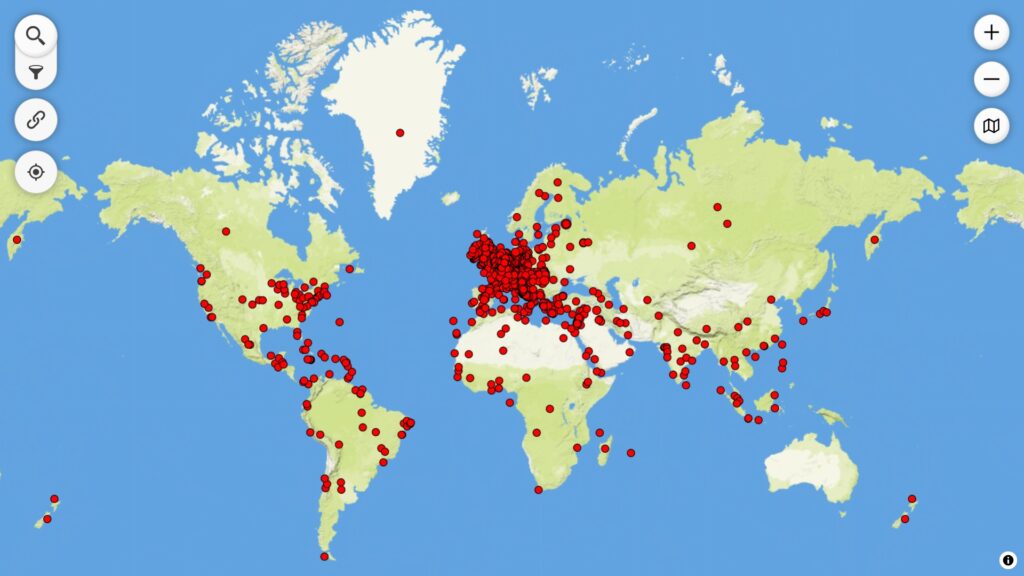
Figure 1. Visualising Sloane’s collections using the Mercator projection in Peripleo.
The fellowship has therefore created a set of prototype alternative interactive web maps using Open Layers, based on projections that preserve distance along meridians (Equidistant Cylindrical) and area (Equal Earth, Albers Equal-Area). The maps are experiments and the product of automated processes and have errors and biases in the distribution of locations. In doing so the work examines how rethinking a commonly-used visualisation form can foster thought-provoking engagement with Sloane’s collections with the intention of stimulating wider applications to visualise the geography of heritage.
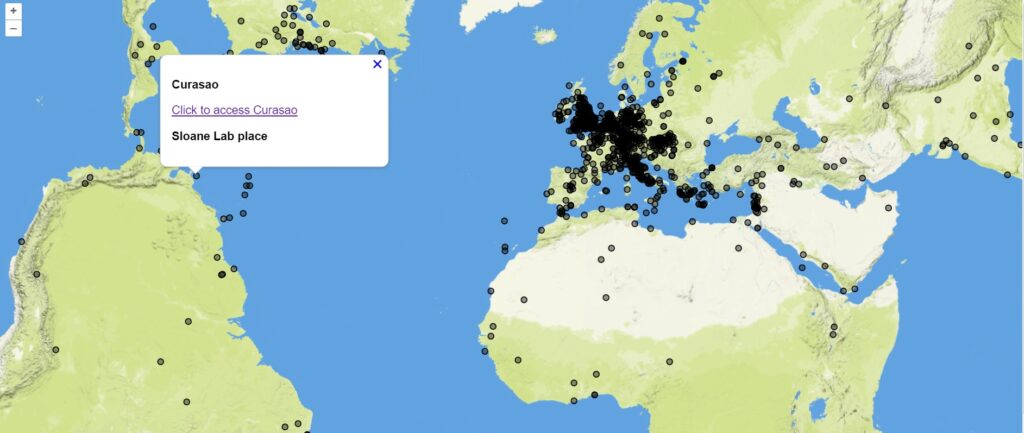
Figure 2. Visualising Sloane’s collections using Albers Equal-Area projection in Open Layers.
Project outputs
- Linked dataset: https://github.com/thegsi/peripleo_sloane/
blob/main/docs/data/Sloane_bm_nhm_types.json - Peripleo web map based on Mercator projection: https://thegsi.github.io/peripleo_sloane
- Open Layers web maps based on Equidistant cylindrical https://thegsi.github.io/Sloane_equidistant/, Equal Earth https://thegsi.github.io/Sloane_equal_earth/ and Albers equal area https://thegsi.github.io/Sloane_albers/ projections.
- Long abstract for DH 2024 conference: https://www.academia.edu/122320237/Finding_Alternatives_to_Web_
Mercator_in_the_Geography_of_Hans_Sloanes_Collection
Joanna Byszuk
Project: Exploring Sloane Lab collections with word vectors
In this project I built a word embedding model of the digitized parts of the Sloane collections to facilitate the exploration of its language. The size and versatility of the collections offer a unique opportunity to examine closer perspectives, e.g. of both the colonizers and those whose culture was ‘collected’. However, they also make traditional research approaches to that problem gruesome and difficult. In order to make such analysis more feasible and accessible, I have created a word embedding model – a representation of the corpus of Sloane collections, so that it can be further examined with curated list of seed words describing selected concepts, a method which allows for the discovery of many more semantically similar words.
The direct outputs of this project include: 1) a vector representation of the examined Sloane collections available freely to explore and use in own studies, 2) interactive training materials showcasing the process of creating and using such resource in a Jupyter Notebook.
These and additional outcomes of the project related to the stylometry of Sloane Letters collections will be available here: https://github.com/JoannaBy/Exploring-with-word-vectors-SLCF
For the latest news from Sloane Lab Community Fellows and in relation to funding calls please check the latest Community Fellowship posts. If you have any questions please contact us.


